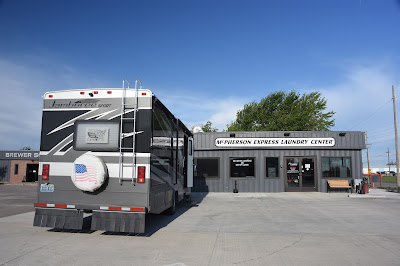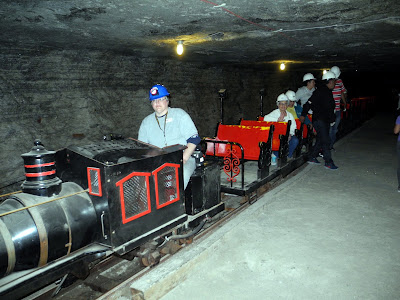Today we didn't go anywhere, mostly because it was raining so ferociously when we woke up, that we came to the conclusion that maybe it would be good day for some reading and writing and studying. Personally, I am glad we took the day off because I made a major discovery in my research on my 2-times great grandfather, John Daley. After several hours of searching the web I discovered where his wife had posted a letter to her brother from St. Joseph, Missouri, in 1852. So, it would appear that they had moved the seventy miles south from Atchison County, Missouri, after 1850 and taken up residence in the thriving city of St. Joe.
Anyway, genealogy aside, I don't have any exciting destinations to write about today so I thought I'd look back over the photos I've taken so far to see if an interesting subject would present itself, and I think one has. What I've decided to do is select a few of my photos and perhaps acquaint you with what I know (or can find out) about the history connected with that object.
In the photo left we have a glass insulator, commonly used to firmly hold electrical wiring to telephone pole cross-arms high above us, mostly to keep us from being electrocuted, but also to keep the electricity from losing some of its charge by discharging into the poles and cross-arms. For more information on this once ubiquitous fixture atop nearly every neighborhood pole, I found the following site: http://www.glassbottlemarks.com/glass-insulator-manufacturers/
"As time went on, networks of “open wire” telegraph lines, and later, telephone lines, were developed and built throughout the country, and these lines required the installation of insulators. Insulators were necessary by serving as a medium for attaching the wires to the poles, but much more importantly, they were required to help prevent electric current loss during transmission. The material, glass, is itself an insulator (not a “conductor” or “transformer” as insulators are often incorrectly labeled in antique malls and flea markets)."
"Both glass and porcelain insulators have been used since the early days of the telegraph, but glass insulators were generally less expensive than porcelain, and were normally used for lower-voltage applications. The oldest glass insulators date from about 1846."
The period from 1875 to 1930 might generally be thought of as the “heyday” of the glass insulator. Hundreds of millions of these glass “bells” were produced during this time by many glasshouses, located primarily in the East and Midwest with a few plants in California and Colorado. Many of the glasshouses that made insulators also produced bottles and other glassware."
"Most insulators are found in some shade of blue-green/aqua-colored glass (typical cheap “bottle glass” or “green glass”) but many, many other color shades are found. Clear glass was used (with some exceptions) primarily after about 1935. Hundreds of different styles were developed, and insulators are found with a wide variety of embossed names, patent dates, and other markings. Many earlier insulators have bubbles, streaking, “snow”, surface creases and other marks of crudeness which was common for this type of glass because quality standards were not usually set as high as tableware. As long as the insulator performed it’s duty adequately, the color and minor imperfections in the glass were of little concern. These “marks of crudeness and age” now add to their value and charm, to collectors of antique insulators."
Like every other history nut who loves antique anything, I have a few of these "treasures" myself. I especially like the ones with bubbles as they just look older. Though you don't see them much anymore, once in a while you'll be off in the woods and run across an abandoned line of poles, and up there just out of reach you'll see an insulator, just waiting for you to be clever enough to get it down.
The next historic subject I want to explore has long ago been forgotten, but once upon a time it was a crucial piece of rural Americana. It was called the "Spring House." I found the following on Wiki:
A spring house, or springhouse, is a small building, usually of a single room, constructed over a spring. While the original purpose of a springhouse was to keep the spring water clean by excluding fallen leaves, animals, etc., the enclosing structure was also used for refrigeration before the advent of ice delivery and, later, electric refrigeration.
The water of the spring maintains a constant cool temperature inside the spring house throughout the year. Food that would otherwise spoil, such as meat, fruit, or dairy products, could be kept there, safe from animal depredations as well.
In settings where no natural spring is available, another source of natural running water, such as a small creek or diverted portion of a larger creek, might be used.
In the accompanying photograph we see a spring house that was actually fed via a well, with a windmill serving as the motive power to pull water from the ground and cycle it through the stone basin you see here. Though I don't know for sure, I suspect that the overflow exit that you see was then channeled to a vegetable garden or similar use. This allowed the farmer or homesteader to utilize the coldest water for "refrigeration" of his perishable foods and then somewhat warmer water would cycle out and onto the garden plants.
As you can see the stone basin actually has to separate compartments, one for the larger milk cans and one for smaller items such as a quart of something that needed to be kept cold.
Unfortunately, I didn't get a photograph of the outside of the Spring House (in this case more properly a "Well House,"), but it was simply a ten foot by 12 foot stone building that would do a good job maintaining a constant cool temperature throughout the summer.
The next item I want to discuss is that most famous of fixtures on an old west cattle drive, the chuckwagon. One source I found said that "The invention of the American chuckwagon is credited to cattleman Charles Goodnight. In 1866, Charles needed a way to keep his drovers fed as they trailed cattle from Texas to the North. A true product of "necessity breeds creativity", Goodnight bolted a wooden box to the back of an Army Studebaker wagon and added compartments to store utensils, bedding, food, and more. The rest, they say, is history.
The term "chuck" is from 17th Century England used by meat merchants who referred to their lower priced goods. By the 18th Century, "chuck" was colloquial for good, heart-warming food. So it is no surprise that Goodnight's invention became known as a "chuckwagon". His simple creativity revolutionized the cattle industry and is now celebrated as the official vehicle of Texas."
As I was putting this piece together it got me to wondering just how many TV westerns and movies showed the cattle stampede, the mad dash of the out-of-control chuckwagon, and the resultant strewing of cooking gear, food, and other necessities all over the prairie floor -- usually in the middle of the night. If I'm not mistaken one of my favorite movies, "City Slickers," did just that.
Here's some more info on the chuck wagon: "Chuckwagon food was comprised of black-eyed peas, beans, corn and cabbage. Of course, there was lots of beef and bison steaks and stews spiced with chilies, garlic, and onion or the occasional catfish or shrimp caught from the rivers, lakes or coastal waters. Sourdough breads (sourdough bullets), quick biscuits, skillet corn bread and cowboy coffee were served with the meals."
Wait a minute! There had to be bacon, didn't there? There's always bacon! Anyway, we read on.....
"The chuckwagon was drawn by oxen or mules. The wagon usually carried food, eating utensils, a water barrel, as well as tools and bed rolls, all tucked away in drawers and shelves and covered by a canvas covering. A hinged counter that folded out was used for chopping and preparing the food."
"The inventor of the chuckwagon, Charles Goodnight was born with the Texas Revolution, came to the state from Missouri the year Texas entered statehood, and, later, with a handful of men, invented the American ranching industry AND the chuckwagon."Here's something else we have encountered on our travels, a Regina pneumatic, hand-operated vacuum cleaner circa 1910. Here's what I learned about the invention of the vacuum cleaner while sitting "home" on this rainy day:
"In 1860 a carpet sweeper was invented by Daniel Hess of West Union, Iowa that gathered dust with a rotating brush and a bellows for generating suction. Another early model (1869) was the "Whirlwind", invented in Chicago in 1868 by Ives W. McGaffey. The bulky device worked with a belt driven fan cranked by hand that made it awkward to operate, although it was commercially marketed with mixed success. A similar model was constructed by Melville R. Bissell of Grand Rapids, Michigan in 1876. The company later added portable vacuum cleaners to its line of cleaning tools."
"The next improvement came in 1898, when John S. Thurman of St. Louis, Missouri, submitted a patent (US No. 634,042) for a "pneumatic carpet renovator." This was a gasoline powered cleaner although the dust was blown into a receptacle rather than being sucked in, as in the machine now used. In a newspaper advertisement from the St. Louis Dispatch, Thurman offered his invention of the horse-drawn (which went door to door) motorized cleaning system in St. Louis. He offered cleaning services at $4 per visit. By 1906 Thurman was offering built-in central cleaning systems that used compressed air, yet featured no dust collection. In later patent litigation, Judge Augustus Hand ruled that Thurman "does not appear to have attempted to design a vacuum cleaner, or to have understood the process of vacuum cleaning.""The motorized vacuum cleaner was invented by Hubert Cecil Booth of England in 1901. And The first vacuum-cleaning device to be portable and marketed at the domestic market was built in 1905 by Walter Griffiths, a manufacturer in Birmingham, England. His Griffith's Improved Vacuum Apparatus for Removing Dust from Carpets resembled modern-day cleaners – it was portable, easy to store, and powered by "any one person (such as the ordinary domestic servant)", who would have the task of compressing a bellows-like contraption to suck up dust through a removable, flexible pipe, to which a variety of shaped nozzles could be attached."
There was James B. Kirby who developed his first of many vacuums called the "Domestic Cyclone" in 1906. There was department store janitor, James Murray Spangler, of Canton, Ohio who invented the first portable electric vacuum cleaner in 1907. Spangler sold his patent to William Henry Hoover, which is a name I'm sure you'll all recognize. The list of inventors of machines and components is very long.
The Regina company who made the hand-operated vacuum pictured here started out in the music box business. When Tom Edison's invention of the photograph cut too drastically into their profits, the company began making vacuums. Just for fun I've included an Regina ad from around the same time as our example machine.
Naturally, there's a great deal more to this story then I can comfortably tell here. Innovations continue to be made to the old "dirt-sucking" gadget all the way up to modern times. If you've got a ancient vacuum in your attic, better drag it out and look at the date. You might have a real treasure.

















































